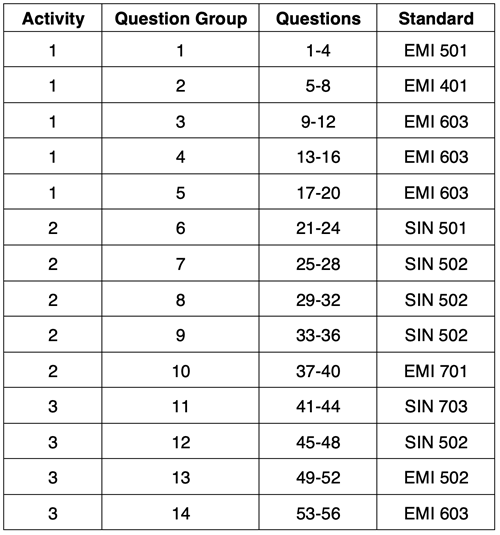About the Science Reasoning Center
About Sticky Tape Experiments
 Highly Recommended
Highly Recommended
Like all our Science Reasoning Center activities, the completion of the Sticky Tape Experiments activity requires that a student use provided information about a phenomenon, experiment, or data presentation to answer questions. This information is accessible by tapping on the small thumbnails found on the bottom right of every question. However, it may be considerably easier to have a printed copy of this information or to display the information in a separate browser window. You can access this information from this page.
The Standards
The Sticky Tape Experiments activity describes a student experiment conducted with two pieces of sticky tape. The interaction of the tape with one another and with a variety of other objects is described. Questions target a student's ability to identify the supporting evidence for a particular conclusion, to draw conclusions that are consistent with two or more data presentations, to make predictions based upon a model, to predict the results of an additional trial, and to understand the design of an experiment.
Success with the activity requires some degree of proficiency with respect to ...
- Asking Questions and Defining Problems (Science and Engineering Practice 1.1)
Ask questions that arise from careful observation of phenomena, or unexpected results, to clarify and/or seek additional information. - Developing and Using Models (Science and Engineering Practice 2.3)
Develop, revise, and/or use a model based on evidence to illustrate and/or predict the relationships between systems or between components of a system. - Constructing Explanations and Designing Solutions (Science and Engineering Practice 6.3)
Apply scientific ideas, principles, and/or evidence to provide an explanation of phenomena and solve design problems, taking into account possible unanticipated effects.
While the Sticky Tape Experiments activity addresses the three NextGen Science and Engineering Practices above, the activity drew its greatest inspiration from ACT's College Readiness Standards for Science Reasoning. The activity consists of 56 questions organized into 14 Question Groups that are spread across the three activities. Two strands (Science Investigation - SIN; and Evaluation of Models, Inferences, and Experimental Results - EMI) of the College Readiness Standards are addressed in this activity. The code given for the standard includes three letters to indicate the strand and three numbers to indicate the specific standard within that strand. Higher numbers are indicative of more complex science reasoning skills. The relationship between the questions and the standards is as follows:

Complementary and Similar Resources
The following resources at The Physics Classroom website complement the Sticky Tape Experiments Science Reasoning Activity. Teachers may find them useful for supporting students and/or as components of lesson plans and unit plans.
Physics Classroom Tutorial, Static Electricity Chapter: Charge Interactions
Physics Video Tutorial, Static Electricity: Charge Interactions
Physics Interactives, Static Electricity: Charging Simulation
Concept Builders, Static Electricity: Getting the Hang of Charge
Concept Builders, Static Electricity: Charge Interactions
Minds On Physics, Static Electricity Module, Mission SE2: Interactions Between Charged Objects
Also see:
Stickey Tape Experiments Activity || Teacher Preview Pages (Task Tracker Teachers Only)
About the Science Reasoning Center || SRC and Task Tracker
Recommended: Print Passage, Tables, and Graphs
Also see: